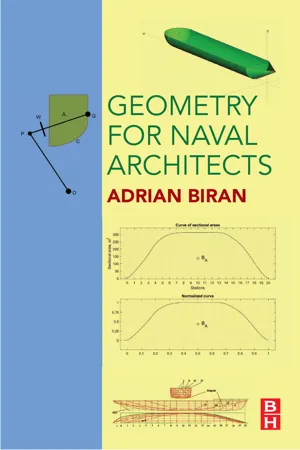Mathematics
Parametric Equations
Parametric equations are a set of equations that express a set of quantities as explicit functions of a number of independent variables, known as parameters. They are commonly used to describe curves and surfaces in two or three dimensions, respectively.
Written by Perlego with AI-assistance
Related key terms
3 Key excerpts on "Parametric Equations"
- eBook - ePub
- Adrian Biran(Author)
- 2018(Publication Date)
- Butterworth-Heinemann(Publisher)
Chapter 4Parametric Curves
Abstract
A curve can be represented by an implicit equation,f ( x , y ) = 0,f ( x , y , z ) = 0, by an explicit equation,y = f ( x ),z = f ( x , y ), or by Parametric Equations,x =,f 1( t )y =,f 2( t )z =f 3( t ) - eBook - ePub
- Morris Kline(Author)
- 2013(Publication Date)
- Dover Publications(Publisher)
t = 1, x = 3, and y = 9. Then (3 , 9) are the coordinates of a point on the curve, namely, the point A , which we discussed earlier. For , x = 4 and y = 16, and (4 , 16) are the coordinates of the point B .We may also say that the two formulas x = 3t and y = 9t 2 are equivalent to the single formula y = x 2 . Whether we speak of equations of curves or formulas is really immaterial. The word formula emphasizes the idea of change because formulas are relationships among variables, and we often like to think of what happens to one variable as another, related variable changes. On the other hand, when a curve is given in its entirety, the concept of change may not be relevant, and then we speak of the equation of the curve.If the two formulas in (1) are entirely equivalent to the single formula y = x 2 , why do we bother with two formulas instead of one? There are two reasons: (1) When one argues from physical principles, it is often easier to arrive at the parametric representation of a given phenomenon, and (2) it is easier to study the phenomenon by working with Parametric Equations. We shall recognize the utility of parametric representations as we study the next few sections.There is one more mathematical detail. Suppose that we find the parametric formulas describing a motion and we wish to determine the direct relationship between x and y . Can we do this? Yes indeed. For example, if x = 3t and y = 4t 2 are the parametric formulas, we can solve the first one for t and obtain t = x /3. We substitute this value of t in y = 4t 2 - eBook - ePub
- Walter Meyer(Author)
- 2022(Publication Date)
- Chapman and Hall/CRC(Publisher)
5 Vectors in GeometryDOI: 10.1201/9780429198328-5Ever since the development of coordinate geometry by Descartes (1596–1650), algebra and geometry have been inseparable. In this chapter, we demonstrate the power of algebraic methods to solve geometric problems. In our use of algebra, we go one step better by using vectors (which have not been invented in Descartes' time). The essential idea here is to pack as much meaning into as few symbols as possible.Applications include topics in computer graphics, industrial design, robotics, and the global positioning system (GPS). The geometric ideas underlying these topics are diverse: lines, planes, spheres, curves. The “storyline” connecting everything is that our concise form of algebra, using vectors, is widely useful.Additional uses of vectors occur to a very mild extent in Chapter 6 and then intensively again in Sections 3 -5 of Chapter 7 . These sections of Chapter 7 can be regarded as a natural continuation of Sections 1 , 2 , and 3 of this chapter.Prerequisites:We assume the reader is familiar with vectors to the extent commonly covered in a semester of multivariable calculus: addition, scalar multiplication, scalar products, and norms.Section 1. Parametric Equations of Lines
The simplest algebraic description of a straight line uses the equation y = mx + b, where b is the y-intercept and m is the slope. This is fine for lines on a plane, but not for lines in three-dimensional space. In this section, we will develop Parametric Equations which can be used for lines in three- and two-dimensions. The Parametric Equations have the advantage that allow a simple description of the line segment connecting points A and B. These ideas will be applied to problems in robotics, computer graphics, and physics.Basic Ideas
Our line equation will be based on vectors. Recall that we draw a vector as a directed line segment (using an arrow) stretching from a point called the tail to a point called the head
Index pages curate the most relevant extracts from our library of academic textbooks. They’ve been created using an in-house natural language model (NLM), each adding context and meaning to key research topics.


